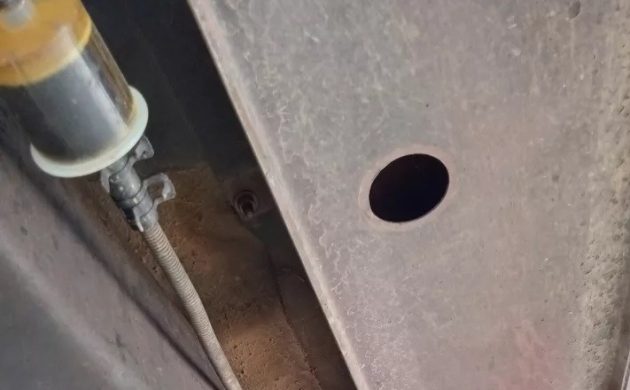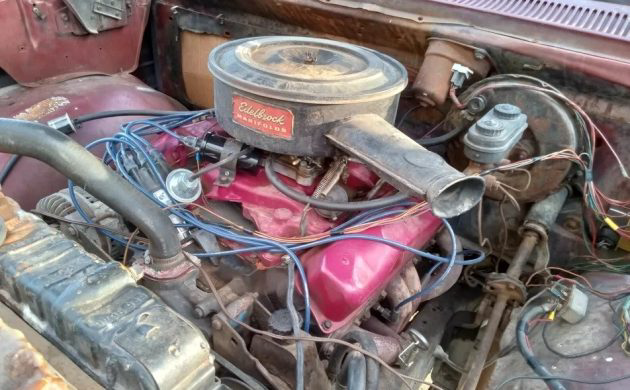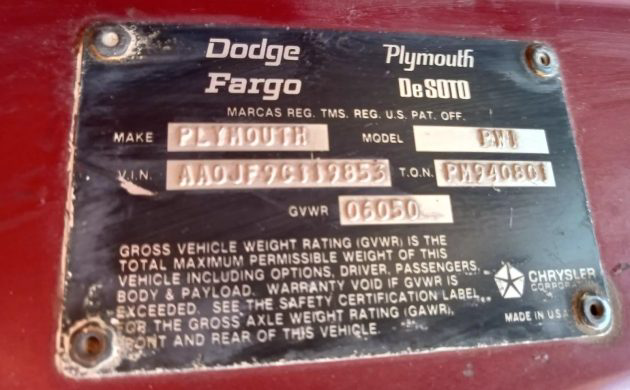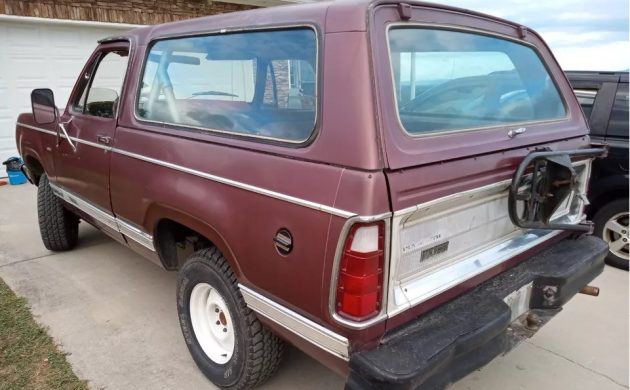The tail end of the 1970s was one of Chrysler’s darkest periods (although things aren’t looking great for them right now). Because of this, you might find it in your heart to forgive them for creating this badge-engineered Ramcharger called the Trail Duster, which neatly piggybacked a little off-road cachet onto a name people already recognized as a sporty compact from earlier in the decade. This 1979 model isn’t exactly a “get-in-and-drive” proposition, but having been an Arizona truck, at least you don’t have to test your tetanus shot while getting it up to snuff.
Indeed, the seller mentions in bold letters that it’s 100% RUST FREE!!! To prove it, there are several pictures of the usual iron oxide hangouts, such as the door bottoms and rocker panels. This particular shot also perhaps gives us a clue as to why the truck recently began running poorly. A spliced-in clear plastic fuel filter shows us that the fuel system could benefit from an overhaul. Add that to the list.
Under the hood is Chrysler’s stalwart big block, the 440. In researching Trail Dusters, I discovered a few things. First, it is hard to find much reliable information on Trail Dusters. Second, the 440 was not an option in the equivalent Ramcharger in 1979, so I have to assume it wasn’t optional in the Trail Duster either. Third, there is no clue as to the engine’s origins in the ad. Perhaps it’s one of those motorhome 440s everyone seems to have. Fourth, the “Edelbrock Manifolds” sticker might be posturing: It looks like a stock manifold to me.
Trail Duster experts are welcome to expound upon or repudiate my findings in the comments.
After spending more time than I expected on VIN decoders this morning, I discovered that this truck was originally built with a 360 2-barrel small block. Of course, some of the information on the internet contradicts itself, but as the 360 was the largest engine available in a Trail Duster 4×4 for 1979, it makes sense.
The 440 is probably an upgrade from the 360, and the rust-free, faded-paint vibe is acceptable to many, but the interior turns this truck into a project (in my opinion). The seller includes a nice selection of pictures in the ad, so you can take a good look around if you’re interested, but it’s going to need a lot of work in here to look presentable. Unfortunately, the roof has also been cut for a 1980s-era two-paneled sunroof.
If you have the right mindset and resign yourself to the fact that you’ll be turning some wrenches before hitting the sand dunes, this Trail Duster looks like a good buy. It’s currently on eBay with a high bid of $5,600 (although it has not yet met reserve). It’s not a bad way to pay homage to the long-gone Plymouth nameplate.








I don’t profess to know many details about 70’s Chrysler products but the VIN tag is strange having the Desoto name on it. I thought they were long gone by 1979. Like almost 2 decades gone. Anyone know what up with that?
I believe that is a generic decal that covers all product lines. I have one on my Dodge pickup and have seen them on other Chrysler Corporation vehicles, mostly trucks.
Fred-
I was thinking the exact same thing!
Maybe they were still using up overstocked “blank” VIN plates from back in the day?
This reply is undoubtedly too late for anyone to see, but I’ll leave it for the record anyway.
The DeSoto Division was still very much in existence in North America in 1979, it just hadn’t had any product to offer its dealers (a few of which still had valid dealer agreements) since 1961 — a legal technicality, since they carried the ever-dwindling number of single-line DeSoto dealers on the books for around twenty years or so to avoid having to pay them to “go away”. Most were offered other Chrysler Corporation franchises over that period as the Chrysler, Dodge, or Plymouth dealers in their market areas surrendered their franchises, but those that couldn’t or wouldn’t accept that solution were simply carried on Chrysler’s books as DeSoto dealers, even though they had no product to sell.
And the Fargo truck line was not part of Chrysler by 1979
Yes it was in South America
DeSoto and Fargo point to a Canadian built vehicle. Regardless of engine origin this is probably a rare vehicle that could deserve a restoration. It wouldn’t be cheap but you’ll have the only one.
I don’t think it is – the tag says “Made in U.S.A” at the bottom corner, and the VIN decoder says that the “C” before the serial number means that it was built at the Jefferson assembly plant, which is in Detroit. Like I said, however, I read some contradictory information online.
It is definitely weird that DeSoto is still on the tag.
For the Canadian market? I find it curious as well. Just shooting from the hip.
The Fargo and Desoto name were used on Chrysler trucks sold in South America during that time period.
Saw quite a few of these up here 🍁 Nelson. Often w snowplows ❄️
I’m sure there were. Canada is a different market for the manufacturers. Mercury Meteors and trucks and Chevrolet based Pontiacs are a few of the anomalies north of the border. Value was the name of the game and Plymouth was a value proposition.
There must be an interesting history that goes with this vehicle. Chrysler did not produce trucks at the Jefferson plant. The ‘C’ in the plant position of the the VIN is quite a mystery.
Everyone chill out ,Howard will give the lowdown when he wakes from his nap..
I had a ’78 Power Wagon with the same VIN tag that had Fargo and DeSoto on it. I just figured that they still had a pile of tags that they had made while DeSoto was a going concern and just used them instead of tossing them out. Interesting to see floors and rockers in one of these, I thought they never had them, around here anyway.
I worked in Product Engineering at the Warren, Michigan Dodge truck plant for the first three months of 1979. The Warren complex included three assembly line buildings: 1) “Warren Truck #1” (Dodge vehicles based on the pickup body), 2) “Warren Truck #2” (the “Sherwood Plant”, which produced motorhome chassis), and 3) “Warren Truck #3” (“Compact RV” vehicles, i.e., cab and frame vehicles based on cab of the van body).
One of my jobs as an engineering intern was to create the 1980 Product Engineering Handbook, a copy of which I still have. I also have a copy of “1979 Chrysler / Plymouth / Dodge / Passenger Cars / Dodge Trucks (Domestic & Imports) Pocket Secretary and Technical Data Handbook”. It was published by the Service and Training Publications Group at Chrysler Corporation. It bears a number of 81-856-9007 on the back cover, the last seven digits of which was likely the phone number of the Tech Publications Group, with 81 being an internal access code. It also shows a price of $1.00.
I never saw a Sport Utility vehicle (Ramcharger or Trail Duster) at Warren, but rather at Jefferson Assembly Plant (on Jefferson Avenue on the east side of Detroit), which I visited once. Jefferson-built vehicles have a “C” as the seventh VIN character.
The only 440 engines in any of the buildings were in Warren Truck #2 and Warren Truck #3. Warren Truck #1 installed only 225 I-6, 318 V-8, and 360 V-8 engines.
The Technical Data Handbook confirms Sport Utility Vehicles were not available with a 440 V-8. It shows that for 2WD models (“AD-1” & “PD-1” Dodge and Plymouth vehicles, respectively) 225, 318, and 360 engines were available. For 4WD models (“AW-1” & “PW-1”), 318 and 360 engines were available.
Page 40 of the Technical Data Handbook contains a drawing of the data plate. It’s identical to this vehicle’s plate and shows Dodge, Plymouth, Fargo, and DeSOTO at the top.
It’s the DIY sunroof that was cut into it, is what I think killed this sale.
Should be able to find another roof!! Still a few Rams and Dusters that are finished, kicking around. Sure wish it was north of the border. I had a 318 4 speed 78 RamCharger and it was the start of my love for top less cars.
Great vehicle for a restoration start or as a daily driver (my preference). Arizona rust free includes shackle bolts, exhaust donuts, etc.